Relationship Between Area and Capacity of Hydrogen Refueling Stations and Derivation of Design Recommendations
Abstract
1. Introduction
2. State of the Art
2.1. Hydrogen Refueling Station Infrastructure
2.2. Hydrogen Refueling Station Operation
2.3. Hydrogen Refueling Station Characterization
2.4. Research Questions
3. Materials and Methods
3.1. Data Collection
3.2. Characterization of the Dataset
4. Evaluation of the Dataset
4.1. Analysis of the Identified Data
4.2. Explanations for the Dataset
5. Design Suggestions for HRSs
5.1. Design Examples for Small-Sized HRSs
5.2. Design Examples for Medium-Sized HRSs
5.3. Design Examples for Large- and Extra-Large-Sized HRSs
5.4. Overall Analysis of Spatial Efficiency
5.5. Morphological Design Catalogue
5.6. Investigating Design Regulations
6. Results
7. Discussion
8. Conclusions
Author Contributions
Funding
Data Availability Statement
Acknowledgments
Conflicts of Interest
Appendix A
| Linear Regression | Region | Data Quality | Size | |||||||
| EU | Asia | 1 | 1–2 | 1–3 | 1–4 | S | M | L | XL | |
| b | 240.8 | 218.1 | 237.7 | 248.3 | 239.1 | 232.1 | 197.5 | 162.3 | 181.5 | 450 |
| c | 0.318 | 0.409 | 0.266 | 0.269 | 0.342 | 0.364 | 0.868 | 0.570 | 0.555 | 0.075 |
| Significance | *** | *** | ** | *** | *** | *** | - | ** | - | - |
| 0.256 | 0.357 | 0.255 | 0.271 | 0.335 | 0.320 | −0.02 | 0.095 | 0.123 | 0.5 | |
| Power Regression | Region | Data Quality | Size | |||||||
| EU | Asia | 1 | 1–2 | 1–3 | 1–4 | S | M | L | XL | |
| b | 3.832 | 3.365 | 3.466 | 3.710 | 3.615 | 3.709 | 2.414 | 3.345 | 1.195 | 4.819 |
| c | 0.346 | 0.428 | 0.398 | 0.365 | 0.388 | 0.369 | 0.704 | 0.422 | 0.778 | 0.208 |
| Significance | *** | *** | *** | *** | *** | *** | - | * | - | - |
| 0.282 | 0.292 | 0.334 | 0.349 | 0.382 | 0.319 | 0.124 | 0.038 | 0.125 | 0.464 | |
Appendix B. Morphological Design Catalog
References
- Nolte, B.; Gollnick, D.; Stein, A.; Vietor, T. Development of a Method for Evaluating H2-Filling Stations. Hydrogen 2024, 5, 851–871. [Google Scholar] [CrossRef]
- H2 Mobility. Wasserstofftankstellen in Deutschland & Europa. 2024. Available online: https://h2.live/ (accessed on 12 June 2024).
- H2 Mobility. Wasserstoffbetankung von Schwerlastfahrzeugen—Die Optionen im Überblick. 2021. Available online: https://h2-mobility.de/wp-content/uploads/sites/2/2021/10/H2M_Ueberblick_BetankungsoptionenLNFSNF_TankRast_2021-10-21.pdf (accessed on 12 June 2024).
- TotalEnergies. 2022. Available online: https://totalenergies.de/ueber-uns/presse/beschleunigter-ausbau-der-wasserstofftankstelleninfrastruktur-h2-mobility-deutschland (accessed on 12 June 2024).
- Krieg, D. Konzept und Kosten eines Pipelinesystems zur Versorgung des deutschen Straßenverkehrs mit Wasserstoff, Jülich; Forschungszentrum Jülich: Jülich, Germany, 2012. [Google Scholar]
- Mayer, T. Modellbasierte Analyse und Optimierung von Wasserstoffprozessketten für Brennstoffzellen-PKWs in Deutschland; TU München: München, Germany, 2020. [Google Scholar]
- Šimunović, J.; Pivac, I.; Barbir, F. Techno-economic assessment of hydrogen refueling station: A case study in Croatia. Int. J. Hydrog. Energy 2022, 47, 24155–24168. [Google Scholar] [CrossRef]
- Hölzinger, N.; Niemeyer, H.; Herausforderungen für den Netzausbau. Tankstelle der Zukunft 2023. Available online: https://www.tankstelle-der-zukunft.de/herausforderungen/ (accessed on 2 July 2024).
- Hof, E.; Kupferschmid, S. Einführung von Wasserstoff—Bussen im ÖPNV: Fahrzeuge, Infrastruktur und betriebliche Aspekte; NOW Gmbh: Berlin, Germany, 2018; Available online: https://www.now-gmbh.de/wp-content/uploads/2018/12/NOW-Broschuere_Wasserstoffbusse-im-OePNV.pdf (accessed on 12 June 2024).
- H2 Tools. Hydrogen Analysis Resource Center. 2024. Available online: https://h2tools.org/hyarc (accessed on 12 June 2024).
- H2 Map. Available online: https://h2-map.eu (accessed on 12 June 2024).
- Clean Hydrogen Partnership. Available online: https://www.clean-hydrogen.europa.eu/index_en (accessed on 12 June 2024).
- Adolf, J.; Fischedick, M. Shell Wasserstoff-Studie: Energie der Zukunft?: Nachhaltige Mobilität durch Brennstoffzelle und H2; Wuppertal Institut für Klima, Energie, Umwelt: Wuppertal, Germany, 2017. [Google Scholar]
- Deobald, S. R—Programmiersprache & Umgebung. 2023. Available online: https://compamind.de/knowhow/r-programmiersprache-umgebung (accessed on 12 June 2024).
- Verordnung über Sicherheit und Gesundheitsschutz bei der Verwendung von Arbeitsmitteln (Betriebssicherheitsverordnung–BetrSichV); Bundesgesetzblatt: Bonn, Germany, 2015; Available online: https://www.gesetze-im-internet.de/betrsichv_2015/ (accessed on 12 June 2024).
- ISO 20100:2008; Gaseous Hydrogen—Fueling Stations. ISO: Geneva, Switzerland, 2008.
- SAE J2601:2016; Fueling Protocols for Light Duty Gaseous Hydrogen Surface Vehicles. SAE International: Warrendale, PA, USA, 2016.
- Corneille, M.; Maier, L. Wasserstoff-Infrastruktur für Straße, Schiene und Wasserwege. 2021. Available online: https://emcel.com/de/wp-content/uploads/2022/12/210821_Wasserstoff_Layout_V10.pdf (accessed on 17 July 2024).
- e-mobil BW GmbH; Fraunhofer-Institut für Solare Energiesysteme ISE; Ministerium für Umwelt; Klima und Energiewirtschaft Baden-Württemberg; Ministerium für Finanzen und Wirtschaft Baden-Württemberg; Ministerium für Verkehr und Infrastruktur Baden-Württemberg. Wasserstoff-Infrastruktur für eine nachhaltige Mobilität; e-mobil BW Gmbh: Stuttgart, Germany, 2013. [Google Scholar]
- H2 Mobility. 70MPa Hydrogen Refuelling Station Standardization -- Functional Description of Station Modules; NOW Gmbh: Berlin, Germany, 2010; Available online: https://www.now-gmbh.de/wp-content/uploads/2020/09/h2mobility_hrs_functional_description.pdf (accessed on 12 June 2024).
- ISO 19880-1:2015; Gaseous Hydrogen—Fuelling Stations. International Organization for Standardization: Geneva, Switzerland, 2015.
- Hydrogen Technologies Code NFPA. NFPA 2: Hydrogen Technologies Code, 2023rd ed.; National Fire Protection Association: Quincy, MA, USA, 2023. [Google Scholar]
- Standard 1910.103; Hydrogen, Occupational Safety and Health Administration. U.S. Department of Labor: Washington, DC, USA, 2023.
- EIGA. Doc 15/20—Safety Distances for Hydrogen Installations; European Industrial Gases Association: Brussels, Belgium, 2020. [Google Scholar]
- Government of South Korea. Korea’s Hydrogen Economy Roadmap 2.0; Ministry of Trade, Industry and Energy: Seoul, Republic of Korea, 2022.


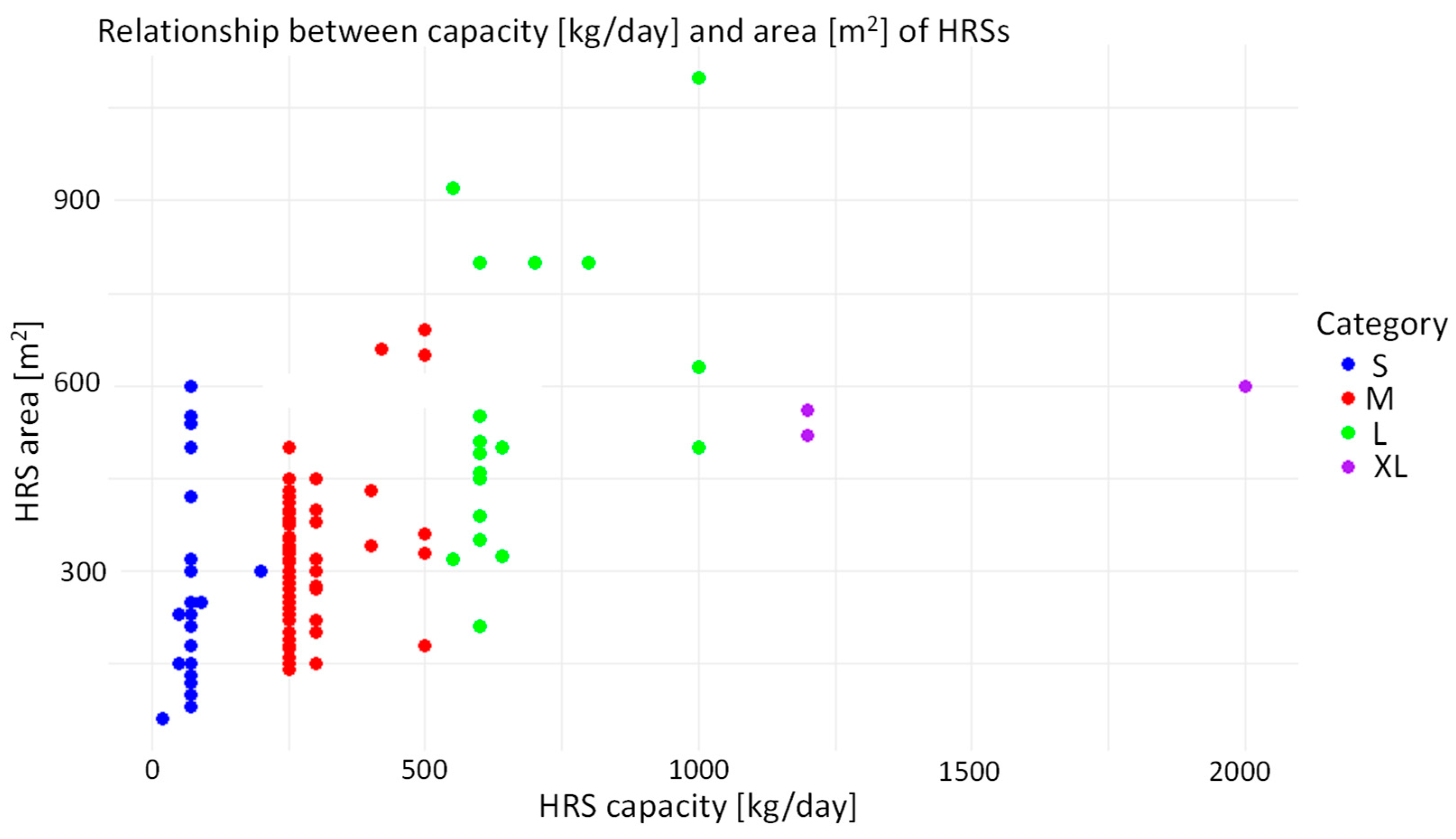
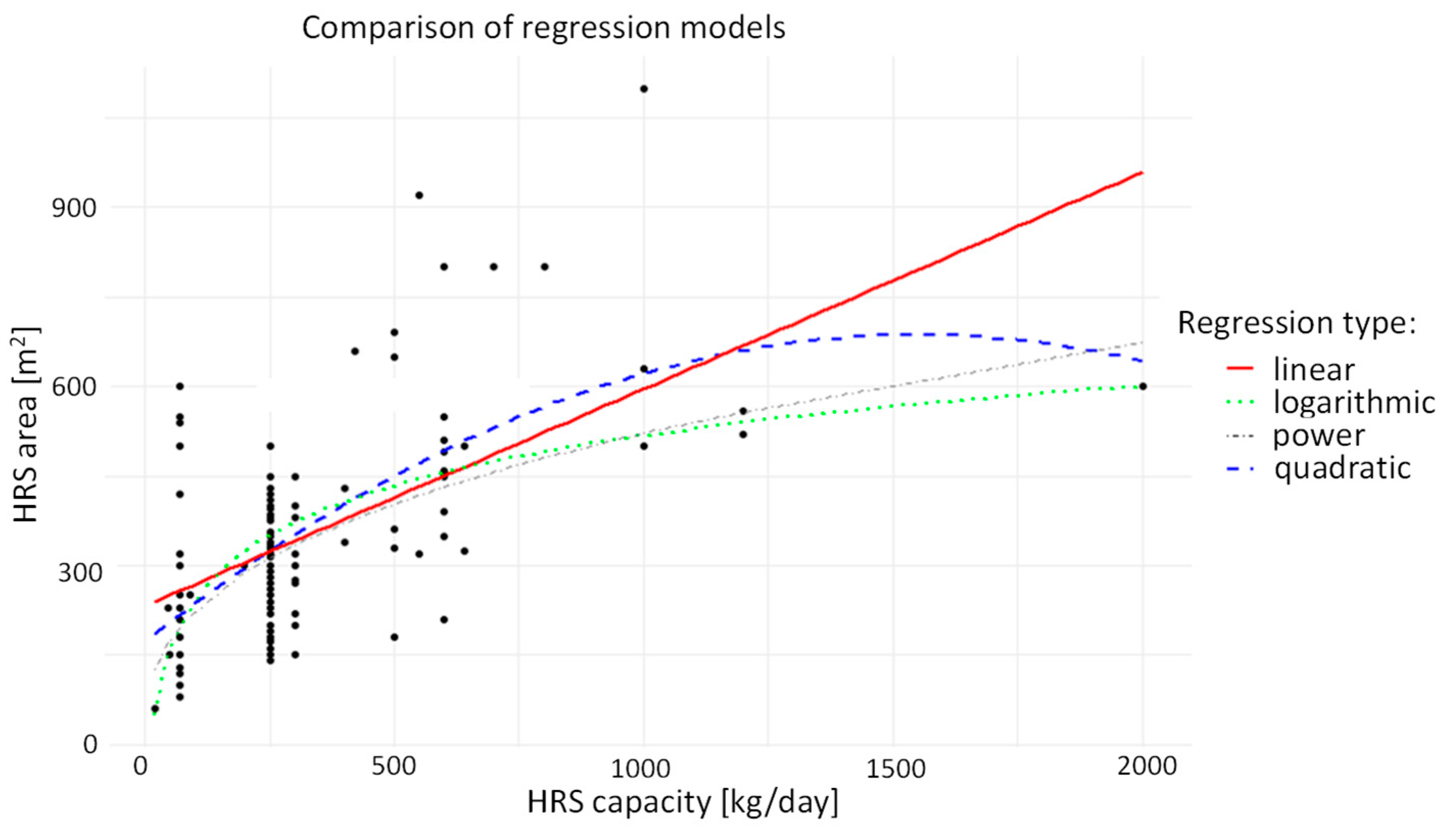
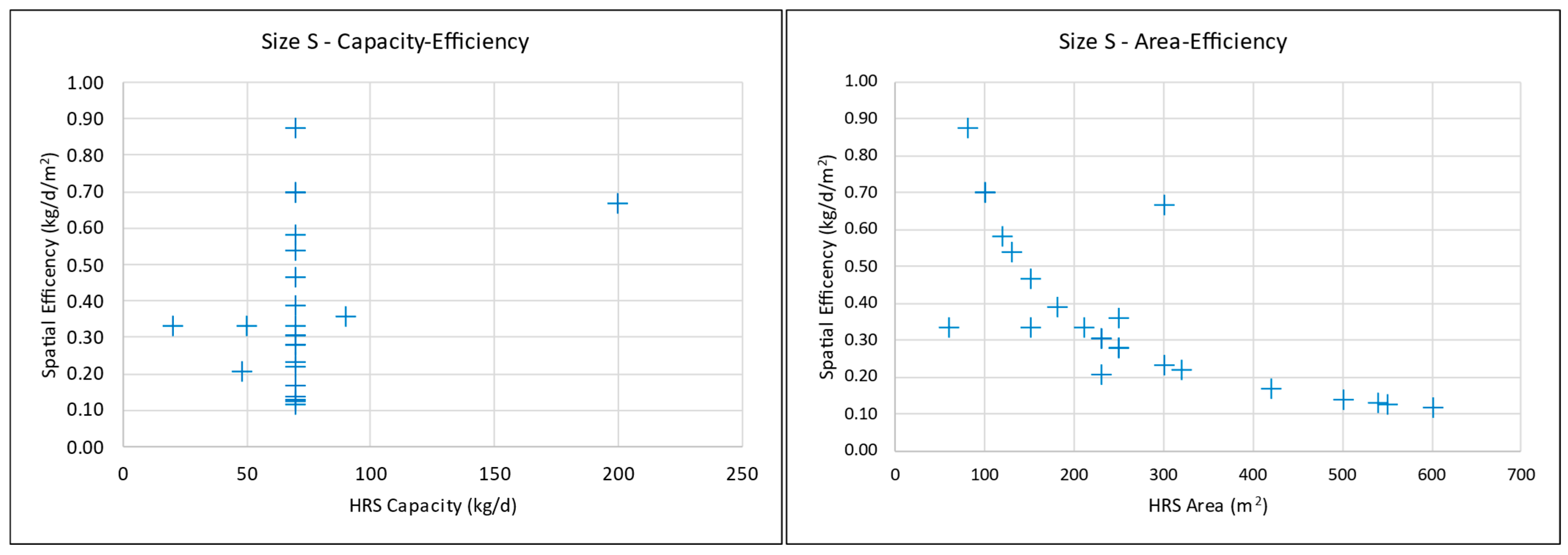



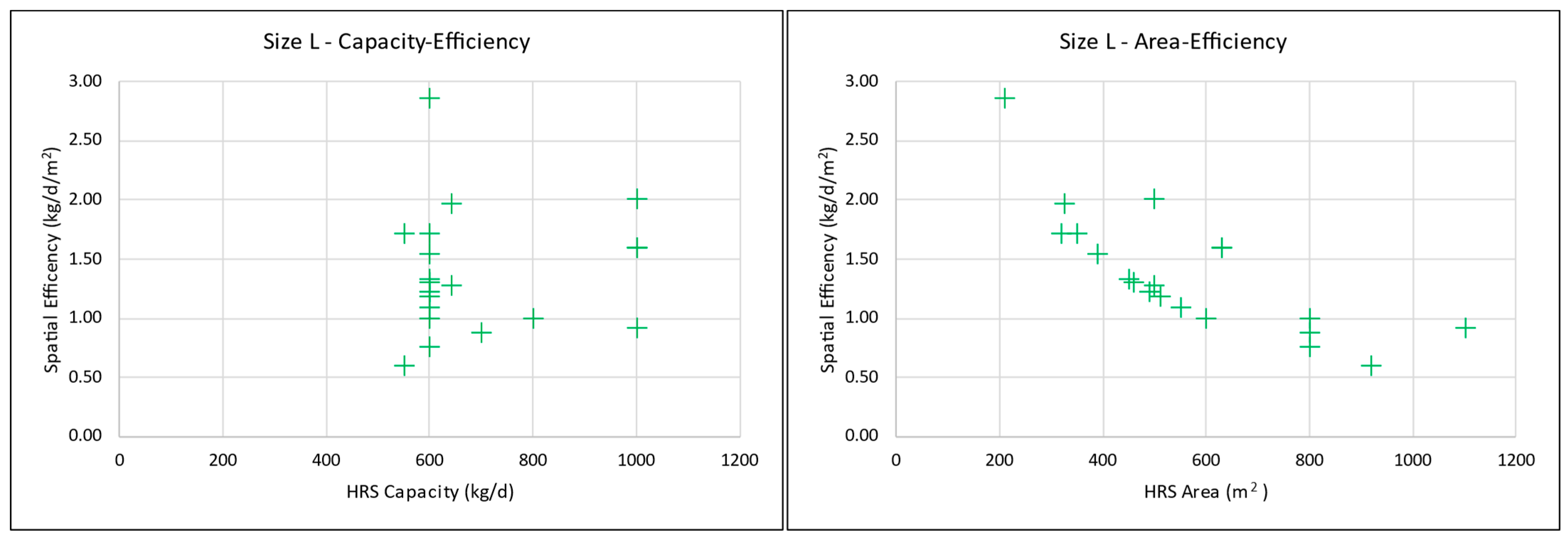

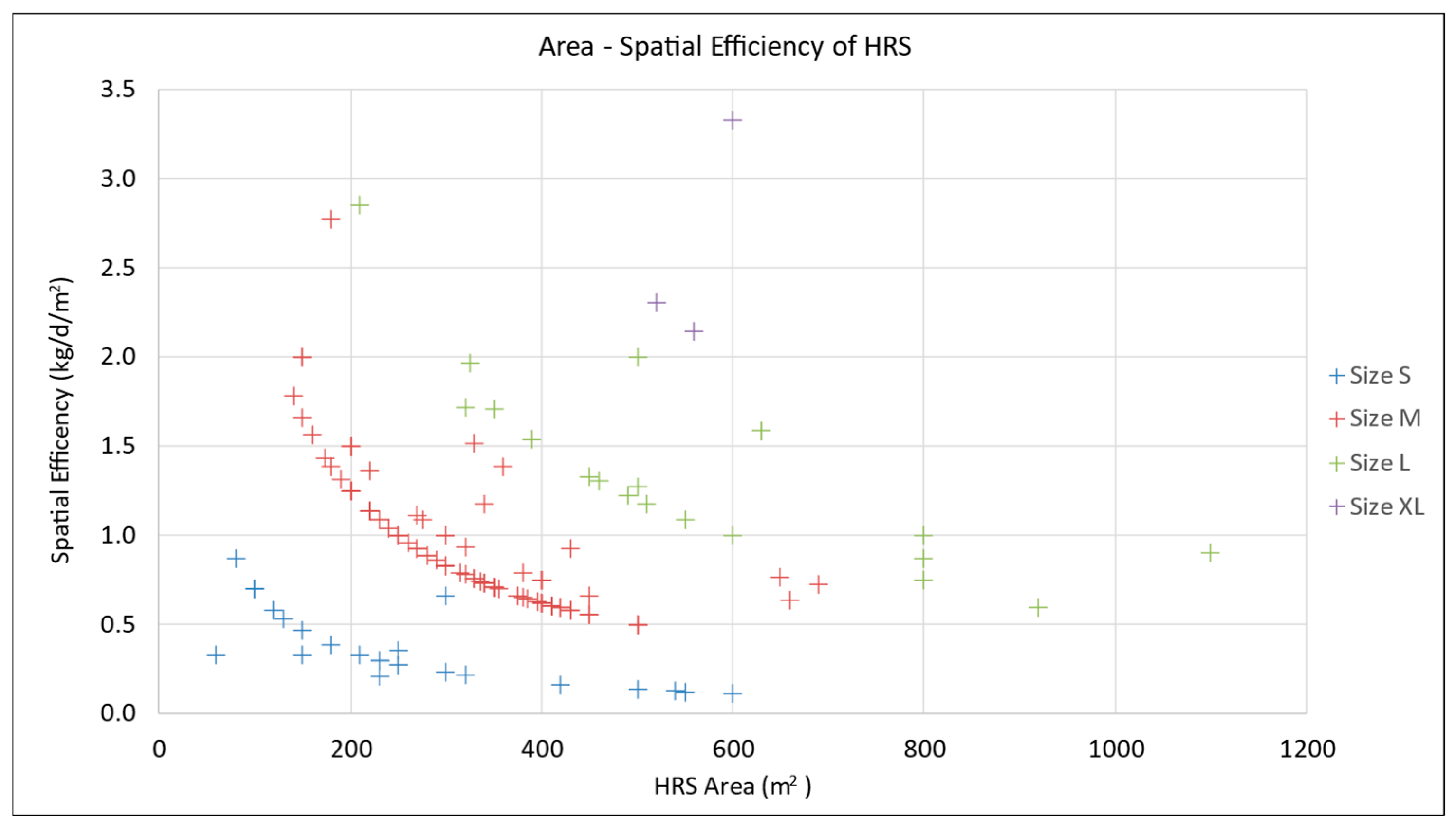

| Data Quality | 1 | 2 | 3 | 4 |
|---|---|---|---|---|
| Amount | 30 | 22 | 3 | 52 |
| Variable | Min. | 1. Quantile | Median | Mean | 3. Quantile | Max. | NAs |
|---|---|---|---|---|---|---|---|
| Data Quality | 1 | 2 | 3 | 2.791 | 4 | 4 | 0 |
| Area [m2] | 60 | 230 | 322.5 | 352.3 | 427.5 | 1100 | 0 |
| Capacity [kg/d] | 20 | 250 | 250 | 330.5 | 300 | 2000 | 0 |
| Number of 350-bar Dispensers | 0 | 0 | 0 | 0.44 | 1 | 3 | 0 |
| Number of 700-bar Dispensers | 0 | 1 | 1 | 1.2 | 1 | 3 | 69 |
| Total Number of Dispensers | 1 | 2 | 2 | 2.108 | 3 | 5 | 69 |
| Start Time | 2012 | 2019 | 2021 | 2020 | 2021 | 2022 | 40 |
| Size | S | M | L | XL |
|---|---|---|---|---|
| Number of Stations | 24 | 87 | 20 | 3 |
| Average Number of Dispensers | 1.7 | 2.16 | 2.8 | 3 |
| Number of Dispensers (per [3]) | 1 | 2 | 2–3 | 2–4 |
| Average Area [m2] | 260.42 | 321.25 | 566.75 | 560 |
| Space Requirement (per [3], [m2]) | 80–250 | 200–350 | 250–800 | - |
| Model | y | x | a | b | c | Significance | |
|---|---|---|---|---|---|---|---|
| Linear | Area | Capacity | - | 0.364 | 232.13 | *** | 0.3195 |
| Quadratic | Area | −0.0002 | 0.664 | 171.7 | ** | 0.3613 | |
| Logarithmic | Area | ln(Capacity) | - | 120.19 | −312.89 | ** | 0.2777 |
| Power | ln(Area) | ln(Capacity) | - | 3.7093 | 0.368 | *** | 0.3189 |
Disclaimer/Publisher’s Note: The statements, opinions and data contained in all publications are solely those of the individual author(s) and contributor(s) and not of MDPI and/or the editor(s). MDPI and/or the editor(s) disclaim responsibility for any injury to people or property resulting from any ideas, methods, instructions or products referred to in the content. |
© 2025 by the authors. Licensee MDPI, Basel, Switzerland. This article is an open access article distributed under the terms and conditions of the Creative Commons Attribution (CC BY) license (https://creativecommons.org/licenses/by/4.0/).
Share and Cite
Stein, A.; Nolte, B.; Kizgin, U.V.; Grünewald, O.; Yurtseven, G.; Vietor, T. Relationship Between Area and Capacity of Hydrogen Refueling Stations and Derivation of Design Recommendations. Hydrogen 2025, 6, 16. https://doi.org/10.3390/hydrogen6010016
Stein A, Nolte B, Kizgin UV, Grünewald O, Yurtseven G, Vietor T. Relationship Between Area and Capacity of Hydrogen Refueling Stations and Derivation of Design Recommendations. Hydrogen. 2025; 6(1):16. https://doi.org/10.3390/hydrogen6010016
Chicago/Turabian StyleStein, Armin, Bastian Nolte, Umut Volkan Kizgin, Ole Grünewald, Güven Yurtseven, and Thomas Vietor. 2025. "Relationship Between Area and Capacity of Hydrogen Refueling Stations and Derivation of Design Recommendations" Hydrogen 6, no. 1: 16. https://doi.org/10.3390/hydrogen6010016
APA StyleStein, A., Nolte, B., Kizgin, U. V., Grünewald, O., Yurtseven, G., & Vietor, T. (2025). Relationship Between Area and Capacity of Hydrogen Refueling Stations and Derivation of Design Recommendations. Hydrogen, 6(1), 16. https://doi.org/10.3390/hydrogen6010016







